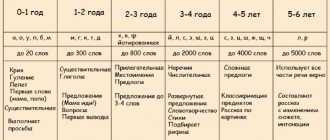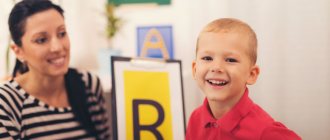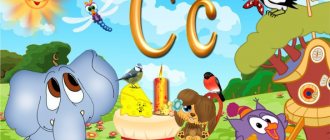Delayed speech development in children 3 years old: causes
Before you start worrying and looking for symptoms of speech development delay (SSD) in your baby, take into account the following: a child’s speech development is a rather individual process.
If your friend’s three-year-old child recites poems from memory, but your baby is silent, this is not a reason to sound the alarm. This is a reason to take a closer look at your baby and his behavior. In addition, the baby will have to undergo a medical examination and, most likely, change his usual leisure activities.
Don’t forget, the concept of “speech” is different for specialists and average parents! Experts distinguish between the passive and active phases of speech, while for parents speech is a speaking skill. If everything is fine with the child’s passive phase of speech, then you need to be patient and wait a little.
And now about the reasons for ZZR. They are biological and social in nature.
Biological:
- Presence of minimal brain dysfunction (MCD). This is a very popular diagnosis today, which is not included in the International Classification of Diseases. Translated into ordinary language, a diagnosis means that there is a certain combination of symptoms indicating that the brain is doing its job a little differently from what is written in smart medical books. The causes of MMD can be: problematic pregnancy and difficult childbirth, frequent illnesses in infancy with their severe course, complications after vaccinations, and traumatic brain injuries.
- Hearing loss.
- Genetic predisposition.
- Presence of cerebral palsy, early autism, Down syndrome, hyperactivity syndrome.
Important: It has been proven that modern children begin to speak later than their peers 20 years ago. The explanation is quite banal: modern children switch to solid food too late. Remember: chewing is the best exercise for the muscles of the speech apparatus!
Social/pedagogical:
- Unfavorable social environment. Alas, in this case we are talking about a lack of communication, which is observed, among other things, among children from prosperous families.
- Emotional stress.
- Bilingualism.
- Overprotection.
- Over-informed environment.
Stages
If we consider the development of a child’s speech by month, we can distinguish several stages:
- Scream. From birth to 6-8 months.
- Booming. From 2 to 5 months.
- Babble. From 6 months to a year.
- First words. Up to two years.
These stages of speech development are very conventional. This means that they can shift by several weeks or months. However, it is this classification that makes it possible to notice if the child’s development differs from normal.
Dorechevaya
- Newborns already have certain vocal reactions - screaming, coughing, sneezing, yawning . Sometimes, towards the end of the first month, children begin to make individual guttural sounds - something like “ae”. The screaming period lasts about three months. It was at this time that the foundations of the protolanguage were laid. Children learn facial expressions, gestures, various manipulations, etc.
- In the second month of life, the baby hums and squeals if he likes something . A differentiation of the cry appears depending on the emotion it shows. Humming is part of the revitalization complex, and the sounds that babies make during this period are: “gi”, “ge”, “ege”, “agu”. Naturally, sounds do not take into account correlation, constancy, relevance, etc. In the third month, the child begins to pronounce intonation sounds.
- In the fifth month, babbling appears . At this stage, it is very important how developed the level of auditory perception is. The peculiarities of speech sounds and syllable formation begin to appear - the child pronounces syllables like “ma”, “ba”, “pa”, etc. Initially, these structures are unstable - they have different durations, the last segment is replaced (ma-ma-ma-boo).
- Prefaces appear at 7 months . This is a closed sequence of syllables united by accentuation. The sounds become constant, the child reacts to his name and listens to the speech of those around him.
- Subject related sounds . Formed by eight months. Children are able to understand individual, frequently spoken phrases. Can look for a familiar object if asked by an adult. By 9 months, a child’s passive vocabulary may contain several short phrases.
Despite its non-verbal nature, it is protolanguage that is the basis for the formation of intelligence and is actively used by children up to two years of age.
Pregrammatical
When a child reaches his first year, his speech, as a rule, already includes his first clearly pronounced words, like: mom, dad, grandma. As for understanding words, a baby going through the dogmatic stage already understands about 30 words. His first words are polysemantic in nature - that is, they sound the same, but mean very different concepts/things. Children have difficulty pronouncing beeps, making it difficult to understand what they are saying. But through constant repetition this is gradually corrected.
Between three months and one and a half years, vocabulary growth slows down, but children continue to master the intonation and rhythmic components of speech. Thanks to this, sounds cease to be similar. The child listens to the speech of adults and tries to liken his speech to what he heard. But usually, each spoken word can stand for an entire sentence. Speech is situational and emotional (children can shout and gesture very loudly).
By the age of two, the child continues to develop a vocabulary, including two- and three-syllable words. First, the syllable on which the stress falls is spoken, then the pre-stressed syllable and the unstressed one. As a result, most words are very difficult to make out. Regarding grammar, children begin to pronounce syllables correctly when their vocabulary is at least 50 words. This is where the next stage of speech development begins.
Mastering grammar
Children begin to go through this stage around the age of two. Up to 2 years and 2 months, children go through the stage of agrammatism, when they speak without formalizing their speech grammatically. Next, kids begin to identify morphemes and form words, albeit by analogy with those they already know. Sentences become three- and four-word. The child begins to talk about everything he sees, talks about his desires and experiences. In general, it says a lot, but it’s not always clear.
From 2 years and 3 months to 3 years, children develop professional vocabulary. Children construct sentences of 3-4 words, and can use familiar words in several grammatical forms. Children's speech changes qualitatively due to inclusion in the game. It becomes coherent and understandable.
From 3 to 7 years of age, vocabulary develops, when a child can use up to four thousand words in speech. A sense of language and grammatical skills are formed. Pronunciation is improving.
These periods vary from person to person, but for most children, speech development occurs this way.
Delayed speech development in children 3-3.5 years old: drug treatment
Important: any self-medication is dangerous! Treating a child with medications without a specialist’s instructions is a crime!
If your baby does not speak and there is no positive dynamics in his development, then you should contact a group of specialists. Be sure to consult with
- a pediatrician who monitors the child from birth,
- pediatric neurologist,
- pediatric otolaryngologist,
- speech therapist,
- Sometimes you need a consultation with a child psychologist and psychiatrist.
Only after consultation can a general set of methods for overcoming RDD, which includes drug treatment, be prescribed.
As a rule, medications that actively nourish brain neurons and participate in the creation of new neural connections are used for drug treatment. In addition, this complex may include a drug that activates the speech centers of the human brain. Some prescriptions may contain iodine-containing medications.
The most commonly used drugs are:
- glycine,
- cogitum,
- cortexin,
- milgamma,
- pantogam,
- Semax,
- tonoten,
- phenibut,
- cerebrolysin,
- cerepro,
- encephabol.
Important: The dosage and duration of the course are prescribed by the attending physician!
In addition to drug treatment, a complex of correctional and developmental activities is required, including
- expansion of the conceptual apparatus,
- development of large and fine motor skills,
- object-sensory therapy,
- music therapy,
- massage, incl. finger,
- charging, incl. finger,
- logorhythmics,
- art therapy,
- articulatory gymnastics.
When to sound the alarm if a child does not speak?
- If up to 8-9 months of life the baby is more silent.
- If a year does not respond when you talk to him. For example, if you ask “where is the chair?”, and he does not turn his head towards where the chair is. And to attract your attention, he often cries.
- If at 1.2 - 1.6 years the child does not distinguish familiar objects by ear and cannot show them in the picture. For example, you ask him to show where the bed is, but he cannot show it either in the room or in the picture.
- If at 1.5 - 2 years old the child does not understand how to fulfill your simplest requests. For example: “Give me a cup from the table,” “Take the little soldier and put him in the box.”
- If at 2–3 years old the child does not speak simple sentences. For example: “Mom, I want to eat”, “Dad, here.”
- If at 3–4 years old a child cannot speak in sentences. For example: “Dad came home from work,” “The dog is lying under the table.” He also pronounces most sounds incorrectly.
How to teach a child to talk at 3 years old: exercises
You will be surprised, but even an ordinary walk can be turned into an entertaining exercise, since it is not a Doman card or a fashionable toy that develops speech, but communication with an adult.
1. Expressively comment on everything your child does. For example, a child opens a door. The adult clearly says: “(Child’s name), opens the door!” etc. This is especially good to do while walking. After all, this is how you can not only name an object, but also voice it. For example: “Look, it’s a cat. Red cat. The cat says “meow”!” etc.
2. If possible, voice all the baby’s actions: fell - “boo-boom”, walks - “top-top”, claps his hands - “clap-clap”, goes to bed – “bye-bye”.
Both exercises should be started as early as possible.
3. A wonderful option for a fun activity: morning exercises accompanied by funny rhymes.
Poems for baby's morning exercises
4. Be sure to learn and recite funny nursery rhymes with a repeating ending. For example,
Little ones, yikes, yack,
Piglet oink-oink,
And the calf is tormented,
Turkey kurla-kurla.
5. Develop phonemic awareness. An example of exercises for developing phonemic awareness can be found below.
Games for developing phonemic awareness
6. Breathing exercises that you can do with your child yourself: blowing out candles, inflating a balloon, blowing a cotton ball into a gate, blowing through a straw into a glass of water. The main task of such exercises is to teach the child to produce an air stream of the required strength and duration.
Examples of exercises for developing speech breathing
7. Articulation gymnastics is designed to strengthen the muscles of the child’s speech apparatus. As a teaching material, you can use a special poster with the entire range of articulation exercises. Exercises for such gymnastics are presented in the video “Speech therapist. Articulation gymnastics. Exercise demonstration."
Features of practicing hissing sounds
To teach a child to correctly pronounce hissing sounds, you must first introduce whistling sounds. If a child in the fourth year of life has learned to pronounce whistling sounds, then there should be no problems with hissing sounds. You can install them with a few simple exercises.
- "Naughty tongue." The child sticks the tip of his tongue out of his mouth. Then he lightly slaps it with his fingers, while saying: “five-five-five.”
- "Delicious jam." The lower lip is pulled down so that the teeth are visible. And the tip of the tongue licks the upper lip, as if it is very sweet there. At the same time, the lower jaw should remain motionless during the exercise.
- “Hide the candy.” Mouth closed. Tighten your tongue and touch your left, then your right cheek. It's like there's candy hiding behind your cheek.
Repeat exercises at least 5 times.
Note! Producing the sounds of native speech is very important for children. It will help them not only make contact with their peers, but also better master the preschool and school curriculum. Parents have the power to help their children avoid difficulties in the future and put the sounds correctly in time.
How to teach a child to talk at 3 years old: games
Don't forget about plasticine, hand and finger painting, mosaic, tactile lotto, etc. In addition, finger puppet theater, in which the main actors are animals, has a remarkable effect on speech development.
Toys for finger puppet theater
Finger gymnastics sessions will not harm the baby at all.
An example of finger exercises for speech development
Who should you contact to identify general underdevelopment?
If a child does not speak at 4 years old, it is better to show him to several specialists at once:
⠀
- speech therapist-defectologist - will assess the severity of the speech disorder and suggest the direction of correctional work;
- ENT specialist - will help make sure that hearing is normal;
- a neurologist - will examine the child, get acquainted with the baby’s development chart to exclude organic damage and, if necessary, prescribe appropriate medications.
⠀
Often, a consultation with an experienced speech pathologist-speech pathologist is enough to determine ODD and begin correction, as in the case of our student Roma.
⠀
But if the speech therapist still recommends visiting other specialists, then you should listen.
How to teach a child to talk at 3 years old: developmental activities
The developments of the Zheleznov father and daughter were highly appreciated by specialists working with various speech defects. The Zheleznovs’ musical materials are often used in logorhythmics classes. A lot of materials for conducting classes are freely available on thematic websites.
Categories of children who need lessons in logarithmics
Breathing exercises
(from about 1.5 years old)
- The wheel burst. First, we clasp our hands in a circle in front of us, depicting a wheel. Then, as you exhale, we begin to slowly cross our arms (so that the right hand rests on the left shoulder and vice versa) and say “sh-sh-sh” - the wheel deflates.
- Pump. Next, we invite the child to pump up the deflated tire. We clench our hands in front of our chest into fists, as if we were holding a pump. We lean forward and lower our hands down, accompanying our actions with the sound “ssss”, repeat several times.
- Loud quiet. We pronounce a sound loudly and quietly. For example, first we pretend to be big bears and say “Uh-uh,” then we pretend to be little bears and say the same thing, only quietly.
- Woodcutter. First, we put our hands together (as if we were holding an ax) and raise them up. Then we sharply lower them down, bending over and saying “uh.” We repeat several times.
- Wizard . First, we wave our hands and hold them at the top. Then we smoothly lower it, pronouncing the syllables: “M-m-m-a”, “M-m-m-o”, “M-m-m-u”, “M-m-m-y”.
Literature on the topic Koltsova M.M. "The child learns to speak"
Currently, there is a large amount of literature devoted to the problem of developing a child’s speech. One of the most recognized and proven books in this area is Baby Learns to Talk.
This book covers the main stages of speech development, and also gives advice on how to promote its development in a child.
What is speech and how did it originate?
According to the author, speech is what allows people to unite, helps them understand each other, and also helps to form common views and beliefs among people.
For your information! Speech is an integral attribute of cognition of the world, distinguishing man from animals, placing him a step higher in development.
It is believed that the prerequisite for the emergence of speech in human format were those signals (often complex) with which animals exchange information about danger, communicate with each other regarding food, sympathy and watering. In other words, they share experiences and impressions and develop an action plan. This is, in fact, what human speech is intended for.
How does a child understand speech, and what is the role of movements in development?
The child compares the words spoken by others with the events and people around him, with the feelings and impressions that he experienced and learned.
According to research conducted by Fomina, speech is directly related to fine motor skills. This is explained by the fact that the projection of the hand occupies approximately 1/3 of the cerebral cortex. The development of speech directly correlates with the development of motor skills of the hands.
How should you talk to your baby?
The conversation must be structured clearly, correctly and completely pronouncing words. It is required to pay attention to the objects surrounding the child, bring him into dialogue, and stimulate the expression of his needs in verbal form.









